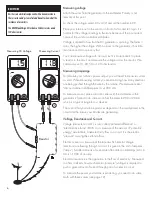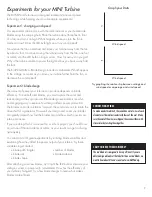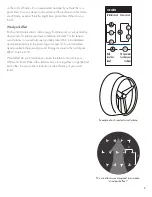
6
Measuring voltage
Attach the wires from the generator to the multimeter. Polarity is not
relevant at this point.
To check the voltage, select DC volt (V) and set the number to 20.
Place your turbine out in the wind or in front of a fan and let it spin. It is
normal for the voltage readings to fluctuate because of the inconsistent
nature of the wind or unbalanced blades.
Voltage is related to how fast the DC generator is spinning. The faster it
spins, the higher the voltage. With no load on the generator, it has little
resistance and can spin very fast.
You can measure voltage with no load, but it is more realistic to place
a resistor in the circuit and measure the voltage across the resistor. We
commonly use 10, 30, 50 or 100 ohm resistors.
Measuring amperage
To calculate your turbine’s power output, you will need to measure current
as well. When measuring current you are monitoring how many electrons
are being pushed through the wire by the turbine. We measure current
from our turbine in milliAmperes.1A =1000 mA.
To measure current, place a load in series with the multimeter so the
generator is forced to do some work. Set the meter to 200 or 20 mA,
which is a typical range for our devices.
The current that your turbine produces depends on the load placed in the
circuit and the torque your blades are generating.
Voltage, Resistance and Currant
Voltage (measured in volts), is also called “potential difference” or
“electromotive force” (EMF). It is a measure of the amount of “potential
energy” available to make electricity flow in a circuit. It is the electric
“pressure” causing the current to flow.
Electric current is a measure of the rate at which electric charge
(electrons) are flowing through a circuit. It is given in the unit of amperes
(“amps”). Smaller amounts of current are often stated in milliAmps (mA). A
mA is 1⁄1000 of an amp.
Electrical resistance is the opposition to the flow of electricity. Measured
in ohms, it reflects how much electric “pressure” (voltage) is required to
push a given amount of current through part of an electric circuit.
To measure the power your turbine is producing, you need to do some
math with these values (see page 12).
Resistors are electrical components with a known resistance.
There is a standard system of colored bands to show what the
resistance of a resistor is.
The MINI Blade Design kit includes a 50 ohm resistor
and a
100 ohm resistor.
RESISTORS
20
20
200
V
A
Resistor
Measuring DC Voltage
Measuring Current
Summary of Contents for MINI Wind Turbine
Page 1: ...MINI Wind Turbine Instruction Manual...
Page 13: ...15...
































